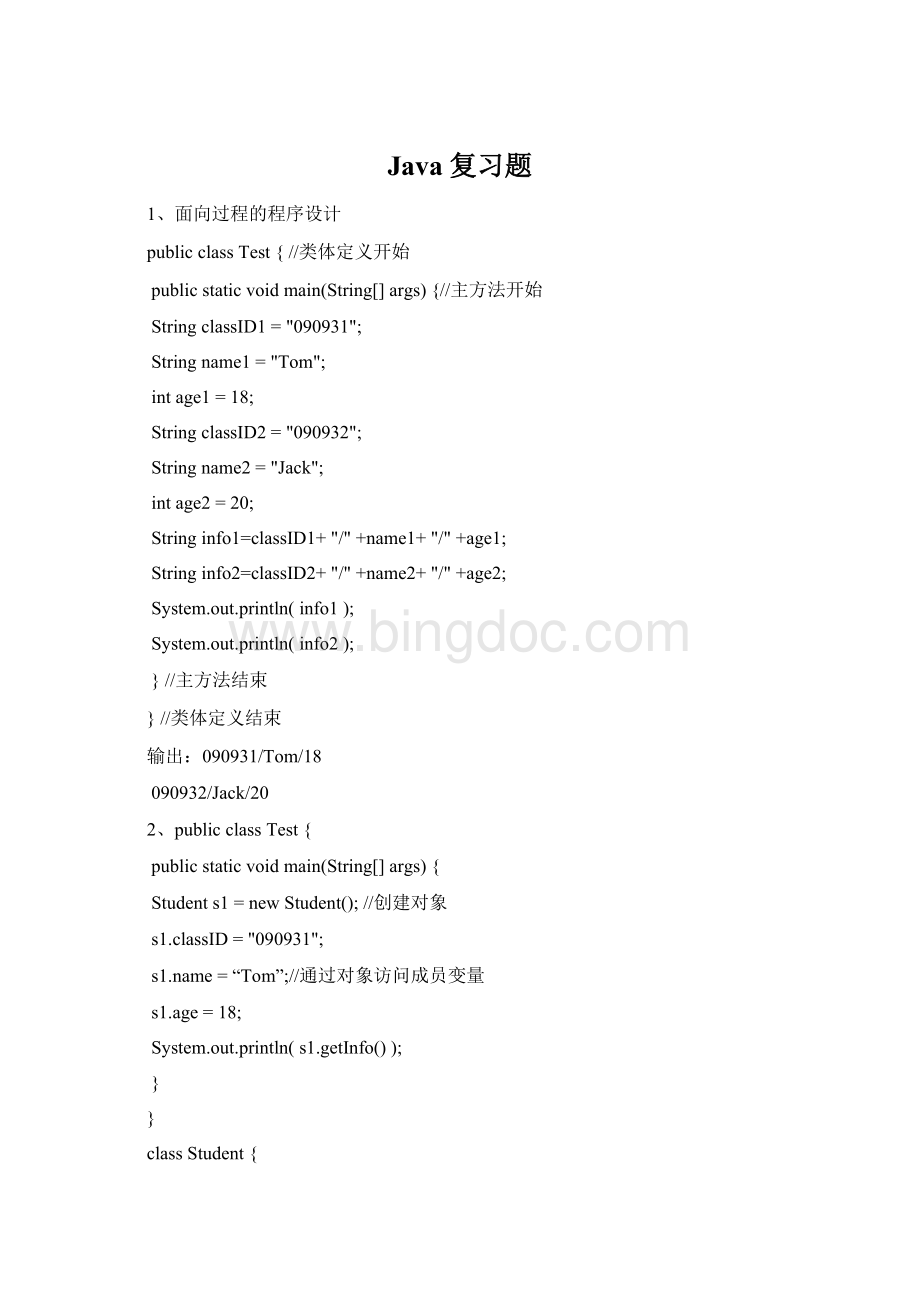Java复习题Word格式.docx
《Java复习题Word格式.docx》由会员分享,可在线阅读,更多相关《Java复习题Word格式.docx(28页珍藏版)》请在冰点文库上搜索。

s1.age=18;
System.out.println(s1.getInfo());
}
}
classStudent{
staticStringclassID;
//班级编号
Stringname;
//学生姓名
intage;
//学生年龄
StringgetInfo(){
returnclassID+"
+name+"
+age;
3、publicclassTest{
s1.name="
Students2=newStudent();
s2.classID="
s2.name="
s2.age=20;
System.out.println(s1.getInfo());
System.out.println(s2.getInfo());
090932/Tom/18
4、publicclassTestStudent{
Students1=newStudent(“Tom”,18);
intage=15;
Student(Stringn,inta){//构造方法
name=n;
age=a;
returnname+"
Tom/18
5、Java语言中,允许一个类可以有多个构造方法
classBox{
doublelength;
doublewidth;
doubleheight;
Box(doublel,doublew,doubleh){
length=l;
width=w;
height=h;
}
Box(doublex){
length=x;
width=x;
height=x;
doublegetVol(){
returnlength*width*height;
6、publicclassTestBook{
Bookbook1=newBook("
Java"
25){
StringgetInfo(){return"
title="
+title+"
price="
+price;
StringgetTitle(){returntitle;
};
System.out.println(book1.getInfo());
Bookbook2=newBook("
25);
System.out.println(book2.getInfo());
classBook{
Stringtitle;
intprice;
Book(Stringt,intp){title=t;
price=p;
StringgetInfo(){returntitle+"
7、局部内部类
publicclassOuter{
privateintx=1;
publicvoidf(finalinty){
intz=2;
classInner{
publicInner(){//定义局部内部类
System.out.println(“x=”+x+”y=”+y);
//可以访问x与y,不能访问z
8、publicclassTest{
System.out.println(newStudent().id);
classPerson{
Stringname,sex;
classStudentextendsPerson{
Stringid;
说明:
若子类和父类都没有定义构造方法,则创建子类对象时,系统将调用父类的无参数构造方法。
9、publicclassTest{
(错的)
Student(){}
Student(Stringid){
this.id=id;
若子类有含参数构造方法,但没有无参数构造方法,则创建子类对象时,必须使用含参数构造方法。
10、publicclassTest{
System.out.println(newStudent(“0801”).id);
Person(){name="
张三"
sex="
男"
Student(Stringid){this.id=id;
若子类有构造方法,则创建子类对象时,系统将首先隐含调用父类的无参数构造方法,然后调用子类自己的构造方法。
11、publicclassTest{
System.out.println(newStudent(…).id);
Person(){}
Person(Stringn,Strings){
sex=s;
Student(Stringn,Strings,Stringid){
super(n,s);
this.id=id;
若子类有构造方法,且在其中的首句使用super显式调用父类的构造方法,则创建子类对象时,系统将不再隐含调用父类的无参数构造方法。
12、子类对象初始化顺序
通过new关键字为子类对象分配内存空间
父类静态成员变量显式初始化
子类静态成员变量显式初始化
父类实例成员变量显式初始化
父类构造方法
子类实例成员变量显式初始化
子类构造方法
得到子类对象
classAnimal{
publicAnimal(){System.out.println("
Animal"
);
classCatextendsAnimal{
publicCat(){System.out.println("
Cat"
classStore{
publicStore(){System.out.println("
Store"
publicclassPetstoreextendsStore{
privateCatcat=newCat();
publicPetstore(){System.out.println("
Petstore"
newPetstore();
Store
Animal
Cat
Petstore
13、父类的引用变量指向子类对象
(1)
publicclassAnimal{
voidrun(){
System.out.println("
Ananimalisrunning."
Animala=newDog();
a.run();
classDogextendsAnimal{
Adogisrunning."
形象理解:
对a来说,它把Dog对象当作了Animal对象(即子类对象可当作父类对象使用)
14、父类的引用变量指向子类对象
(2)
voidrun(){System.out.println("
animalrun."
voidact(){run();
a.act();
protectedvoidrun(){
dogrun."
15、classBook{
Stringtitle,author;
voidgetInfo(){
System.out.println(title+“,”+author);
Stringid,name;
System.out.println(id+“,”+name);
publicclassTest1{
publicstaticvoidmain(String[]args){
…
一个程序中出现了同名方法
16、classBook{
classEBookextendsBook{//电子书
Stringurl;
//网址
super.getInfo();
System.out.println(url);
publicclassTest2{
publicstaticvoidmain(String[]args){…}
继承引发的多态性——方法覆盖
17、classMyMath{
staticintsum(intx,inty){
returnx+y;
staticintsum(intx,inty,intz){
returnx+y+z;
staticintsum(floatx,floaty){(错的)
staticfloatsum(intx,inty){
publicclassTest3{
封装引发的多态性——方法重载
18、classBook{
Book(Stringt,Stringa){
title=t;
author=a;
classEBookextendsBook{
EBook(Stringt,Stringa,Stringu){
super(t,a);
url=u;
publicclassTest4{
publicstaticvoidmain(String[]args){
Bookbook=newEBook(“Java编程”,“张三”,“http:
”);
System.out.println(book.url);
对象引用引发的多态性,子类对象可当作父类对象使用
19、窘境:
构造方法中引用动态绑定方法1
classA{
intsum(intx,inty){returnx+y;
A(){System.out.println(this.sum(4,6));
classBextendsA{
publicB(){}
protectedintsum(intx,inty){
returnx*10+y*10;
publicclassTest{
newB();
}//不要在父类构造方法中调用被子类重写的方法
20、窘境:
构造方法中引用动态绑定方法2
publicclassTest03{
publicstaticvoidmain(String[]args){newB(5);
voidshow(){System.out.println("
A.show()"
publicA(){this.show();
privateintx;
publicB(intx){
System.out.println(this.x);
this.x=x;
{x=2;
B.show(),x="
+x);
输出:
B.show(),x=0
2
5
21、算术运算异常的捕获和处理
importjava.io.*;
publicclassUseException{
publicstaticvoidmain(String[]args){
try{
inta,b;
a=Integer.parseInt(args[0]);
b=Integer.parseInt(args[1]);
System.out.println(a+"
/"
+b+"
="
+(a/b));
}catch(ArithmeticExceptione){
System.out.println("
捕获了一个异常,除数不能为0!
"
}
}
22、异常处理例
classTestException{//该类的方法中会抛出异常
privateinti;
privateint[]array={1,2,3,4,5};
//定义一个含5个元素的数组
voidm1(){//该方法中会出现数组下标越界异常,且无处理
for(intj=0;
j<
10;
j++){
i=(int)(Math.random()*10);
下标为"
+i+"
的数组元素是"
+array[i]);
}//endofm1()
voidm2(){//该方法中会出现数组下标越界异常,但有异常处理
try{
catch(ArrayIndexOutOfBoundsExceptione){
在m2方法中出现数组下标越界"
}//endofm2()
voidm3()throwsUserException{//抛出自定义异常,但未处理
if(i>
=3)thrownewUserException("
下标偏大"
}//endofm3()
}//endofclassTestException
classUserExceptionextendsException{//自定义异常类
publicUserException(Stringmsg){
super(msg);
23、一维数组静态初始化
数组成员是引用类型的也可静态初始化
Point[]pa={newPoint(1,4),newPoint(3,9)};
classPoint{
intx,y;
Point(inta,intb){
x=a;
y=b;
}
24、一维数组动态初始化
数组定义与为数组分配空间和赋值分开进行
inta[]=newint[3];
a[0]=1;
a[1]=5;
同样,引用类型的数组成员也可动态初始化
Point[]pa=newPoint[3];
pa[0]=newPoint(1,4);
pa[1]=newPoint(3,9);
classPoint{
y=b;
}
课堂习题
1、对于类Book,下列选项中,正确的构造函数定义是(C)
A.book(titleString,authorString)
B.book(title,author)
C.Book(Stringtitle,Stringauthor)
D.Book(title,author)
2、以下选项中,(B)是对父类方法StringgetInfo()的覆盖
A.intgetInfo()
B.StringgetInfo()
C.StringgetInfo(Strings)
D.StringgetInfo(inti)
3、关于方法的重载,以下叙述错误的是:
(C)
A.方法的重载是通过在一个类中定义同名方法实现的
B.重载根据不同的形式参数列表来区分同名的不同方法
C.方法的重载是继承的一种表现
D.重载方法的方法名相同,是因为它们的最终功能和目标相同
4、下列选项中,(A)不是方法publicvoidprint()的重载方法
A.publicStringprint(Stringx)
B.publicvoidprint(charx)
C.publicvoidprint(intx)
D.publicvoidprint(Stringx)
5、publicclassTest{//定义主类Test
Dogdog=newDog();
dog.run();
Runnerhorse=newHorse();
Test.run(horse);
voidrun(Runnerr){r.run();
interfaceRunner{voidrun();
classDogimplements